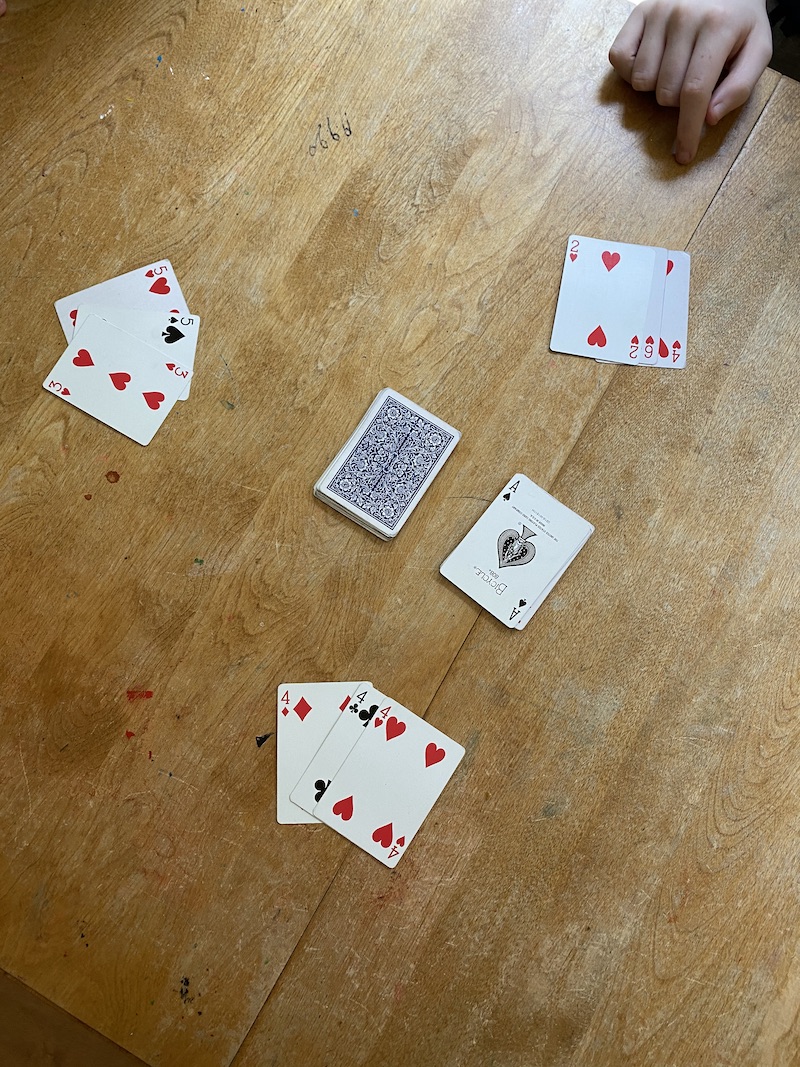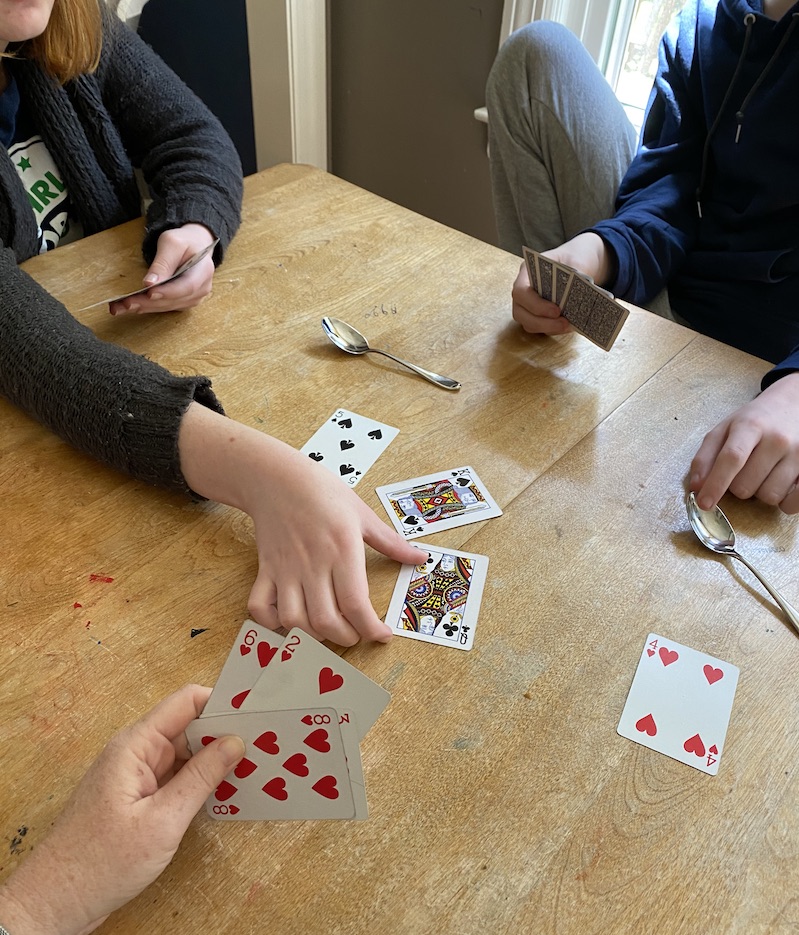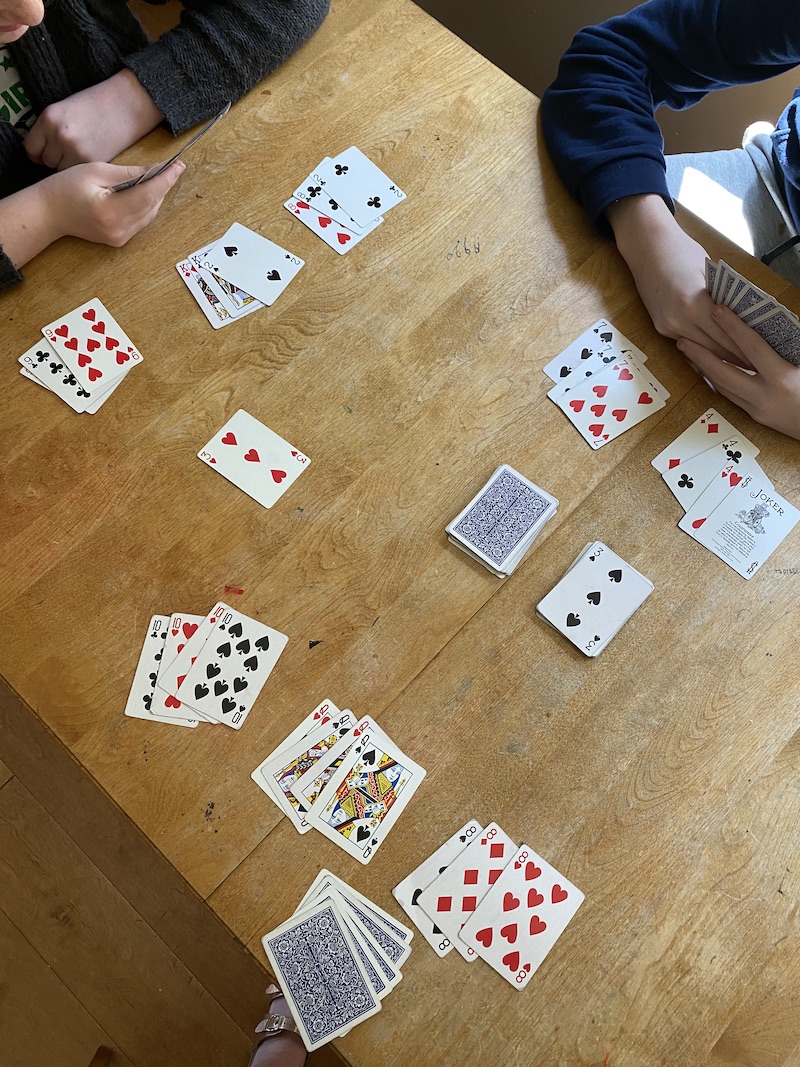We’ve all had a lot of (ahem) together time recently, and we’re honestly starting to get a bit bored the same board games. There’s only so many rounds of Apples to Apples I can play before it’s not so funny anymore. So lately, we’ve turned to some easy card games kids can play that require a little more thinking — and are a lot more interesting than Go Fish or Old Maid.
Turns out, they’ve been a huge hit with our kids! As in, our teens have actually come out of their rooms and asked if we could all play together as a family.
Gasp.
So here’s a list of the card games my kids have been loving, along with the quick rules so you can add them into your own family game night rotation. I’ve also offered up some tips for playing them best with different ages.
This post contains affiliate links
Related: 8 board games you can play over FaceTime or Zoom for remote fun with friends
Fun card games for kids: Pass the Trash

There are many different versions of a card game with the name Pass the Trrash, but the version we play is simple enough for young kids and very quick.
What you need: One 52-card deck plus chips for each player. We usually use 3 chips each, but you can use more if you like. Of course you don’t need actual chips — you can use candy, coins, cookies, pieces from other games, you name it.
How to play: The goal is not to have the lowest value card in your hand at the end of the round.
In each round, the dealer gives one card to each player. Going around the table, each player must decide whether they want to keep their card or pass it (trade it) with the player to their left. The dealer is able to turn the top card of the pile as their own “pass/trade” action.
Aces are ones, so they have the lowest card value. Kings are the highest, and must be flipped over immediately and cannot be traded. So, if someone has a low card they wish to pass, however the person to their left puts down a king, the first player is stuck with their low card.
After going around the table once, all the cards are revealed, and the person holding the lowest card must put a chip in the pile.
What ages can play? Even very young kids can play this game, since you’re just playing with one card at a time. If it helps, team up with a very young kid for a few rounds, then let them play on their own once they’ve got the hang of it.
Related: How to play Crokinole: The best game you’ve never played
Fun card games for kids: Three-Thirteen

I found my ten- and twelve-year-old playing this game together in the kitchen the other day, completely on their own! It’s a been a favorite of ours for a while.
What you need: One standard 52-card deck plus Jokers for two players. If your’e playing with 3-4 players you need two decks, though we use two decks for up to six players and it works fine.
How to play: The goal of the game is to get all your cards into “melds” (stacks) of at least three cards. They can include runs of three in the same suit (i.e. the 3, 4 and 5 of spades) or a set of three cards of the same rank (i.e. three 7s). In this way, it’s similar to gin.
To start the first round, the dealer deals each player three cards. In subsequent rounds, you increase the cards you deal by one card each time until the eleventh round when you get to thirteen. (Thus, the name three-thirteen). The remaining cards are placed in a pile in the center of the table, with the top card flipped over to start a discard pile.
To begin play, each player draws one card, either from the top of the pile, or the top card from the discard pile then adds it to their hand. Next, they discard a card that they don’t think they will be trying to meld.
Jokers are wild. In addition, there will be a different wild card for each round based on the number of cards dealt. This means in the first round, when you deal three cards, the 3 is the wild card. In the second round, when you deal four cards, the 4 is the wild card, and so on.
Any player who discards an ace can now change the wild card to one of their choice. It must be changed. Also, a player may not discard an ace, change the wild card, and “go out” in the same turn. They may, however, discard the ace without changing the wild card when they go out.
After the first player goes out, every other player gets one more turn to draw, make melds, and discard the cards in their hands. Any cards remaining in your hand that cannot be made into melds are added up:
-2 through 9s count as five points each
-10s through Ks are ten pointe each
-Aces and Jokers are twenty points each.
The goal is to have the lowest score.
Once all your cards have been placed into melds, you discard and “go out” to end the round.
What ages can play? Kids as young as eight years old should be able to get the concept after trying a few rounds “open,” in which you play with all the cards showing so you can teach the new players. The hardest part is keeping track of which card is wild, because it keeps changing as the game goes on.
Related: The best group card games to play with the whole family
Fun card games for kids: Spoons

If you’re looking for a fast, fun, and rambunctious card game for kids, then Spoons is the one to try. Think: musical chairs plus the basketball game HORSE, but with cards.
What you need: One 52-card deck, plus enough spoons for each player minus one. You need at least three players to play.
How to play: The object is to make four of a kind. Once you do, you grab a spoon quickly. Everyone else then must try to grab a spoon, and the last player to grab one — because they will be left without a spoon — gets an S added to their score. The next time, you get a P, and so on. Once you complete the word SPOONS with your score, you’re out.
You start play by putting the spoons in the center of the table and dealing each player four cards. The dealer flips four cards face up in the center of the table and yells GO! Now, all players are simultaneously allowed to pick up and discard one card at a time, to help them reach 4 of a kind.
If no one wants any of the cards left on the table, each player says “pass.” Those cards are then, discarded and four new ones are dealt.
Play continues this way until someone gets four of a kind and grabs a spoon.
The winner is the last person remaining who has not spelled the word SPOON.
What ages can play? Since there is only one type of meld to be made — four of a kind — Spoons is a simple enough card game for kids that even preschoolers can play on their own after a few practice rounds. But the real fun in this game is that it’s supposed to be played very quickly, in rapid rounds, with everyone clamoring for a spoon at the end. This isn’t a nice, polite game of Bridge.
Related: Our favorite group card games for family game night: Exploding Kittens and more.
Fun card games for kids: Spite & Malice

This is a great two-person card game that’s similar to solitaire, and kids can easily play together without an adult once they’ve gotten the hang of it.
What you need: Two standard 52-card decks. Aces are low, Kings are wild, and suits don’t matter. The max number of players is two.
How you play: Twenty cards are dealt to each player then placed in a “payoff pile.” The rest of the cards are placed in a separate pile, face down, as the “stock.”
The object is to move all of your cards from your payoff pile to center stacks — four stacks of cards in the center that start with an ace and build up to a Queen. (Kings are wild.) So it’s similar to solitaire but without the restrictions on color and suit. So an ace of spades could be followed by a two of hearts, then a three of diamonds.
A King can be played as any number you’d like to help you build your piles.
Game play starts with each player flipping the top card on their payoff pile; the one with the higher card goes first.
The first player now draws five cards from the stock pile. If they have an Ace or a King (wild, used as an Ace), they may begin a building pile in the center of the table. Then, they can continue to add any other cards in progression, from their hand to the pile or to the top of their payoff pile.
If you use all five cards that are in your hand, you may draw five more and continue play.
Your turn ends when you have no more cards to add to the building piles in the center of the table. Then, you discard a card of your choice from your hand to a personal discard pile. (You may have four total, and only the top card from each pile may be used.)
Then, the next player draws their five cards from the top of the stock pile and continues the same actions.
On each subsequent turn, the player will draw enough cards from the stock pile to get their hand back up to five cards total.
Once a middle building pile gets to a Queen, the opposing player shuffles that entire pile into the stock pile, and the player continues their turn.
When a player uses the last card from their payoff pile, eliminating all their cards, they win the game.
What ages can play? With some patient coaching, a child as young as eight could figure this game out after a couple of turns. The layout can be difficult to picture, and this video tutorial of Spite & Malice by Gather Together Games might be helpful to watch first. But once they get the hang of it, they’ll want to play this one over and over.
Related: 7 great family board games that take 30 minutes or less to play
Fun card games for kids: Canasta. (Yes, really!)

If you thought Canasta was just for grandparents, wrong! it’s a great family card game when you have adults in the family who want to play something a little more strategic, along with kids also like strategic games, but games like Pinochle or Bridge too complicated and serious,
It’s simple in that you are only making matching cards by rank (face value), no runs or other more complicated pairings.
What you need: You need two 52-card decks and Jokers, and Canasta is best when you have three or more players. If you have a big family you can play as teams, but with kids I suggest starting by just playing individually. You can also use a specialized Canasta deck of cards, which can be helpful for new players since it includes the point values written on each card.
How to play: The object of the game is to score points by making melds of at least three cards of the same rank (i.e., three 7s). The first person to use all the cards in their hand in their melds and also has a “canasta” (i.e., seven cards of the same rank) can go out.
Know that some cards have special values! 2s and Jokers are wild cards. Red 3s are worth one hundred points, and if you draw one of these (or are dealt one at the beginning) you set it on the table in front of you and immediately draw another card. Black 3s have a special function I’ll mention below.
To start the game, the dealer gives each player eleven cards and sets the rest in the center of the table as a draw pile. The top card is flipped over as a discard pile.
On your turn, you draw the top card from the draw pile and add it to your hand, making melds if you would like to. Then, discard a card. Alternatively, you may draw from the discard pile, which is where the game starts to get fun — there are lots of points to be gained for the person who takes it!
In order to take the discard pile, you must be able to use the top card to make a meld or to add to a meld you already have on the table.
However, if the person before you discards a black 3, then the pile is frozen for you. If they discard a wild card, it’s turned sideways and the discard pile is frozen until someone can make a new meld from their hand with no wild cards. As each turn goes around the table, the anticipation builds until someone finally takes it!
Once someone has at least one canasta (a meld of seven cards that includes no more than three wilds) and they discard their last card into the discard pile, then the round ends immediately. All players now deduct the points they are holding in their hands — even if they could have been used to make melds.
Now everyone counts the points they have on the table and deducts what’s left in their hands: Canastas are 300 points, or 500 points if you manage to make one with no wild cards. Then, each individual card is added to your score:
-Black 3s through 7s are five points each
-8s through Kings are ten points each
-Aces are twenty points each
-red 3s are one hundred points.
Plus, the person who went out first gets a bonus of one hundred points.
What ages can play? Because the melds are simply cards of the same rank, any kid who loves cards should be able to figure this one out, but it does take a little more experience. My kids were playing like pros (well, maybe not quite like pros) after just a few hands and have been begging us to play more. I found this 5-minute Canasta video tutorial by Queen’s Slipper to be really helpful, as kids can easily gloss over the rules without a visual aid.





